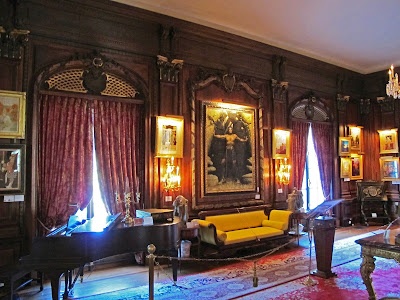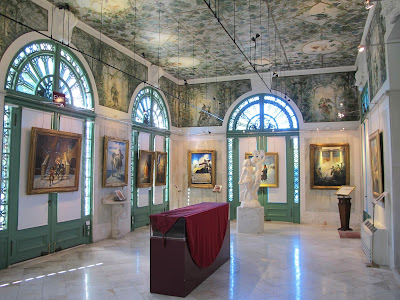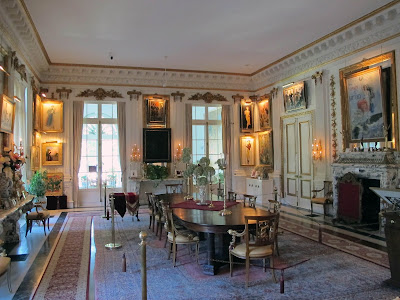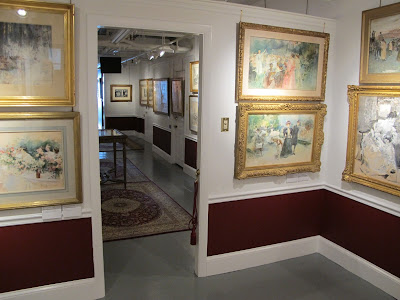Who was Anna Gambrill? And how could you not know how to set a table if you lived in a house like this?
First things first: Anna Gambrill bought a swanky Newport lot at 492 Bellevue Avenue in 1898. By 1900, according to a society squib in "The New York Times," she was ready to commit $300,000 to a new villa. Completed in 1901, the main gate is on Victoria Avenue, a stone's throw from Bellevue and 2 blocks from the Breakers.
By the time the house was finished, there hadn't been a Mr. Gambrill for over 10 years. Richard A. Gambrill (1848-1890), native of Baltimore, graduate of Harvard, resident of Brooklyn, was practically a newlywed (married April, 1888) when he succumbed to the flu at age 42. At the time of his death he was on a steep upward career curve, in law and railroads. Fortunately, his widow, far from being impoverished, had considerable financial resources of her own.
Brooklyn born Anna Van Nest Gambrill (1865-1927) was one of the 2 daughters of railroad man Alexander T. Van Nest (died 1897). Sorting out the railroad holdings of these old guys is like playing Scrabble with an inexhaustible list of small midwestern cities. Illuminating to note, when Van Nest dropped dead prior to a directors' meeting of the Chicago Rock Island and Pacific, social and financial magnate Ogden Mills was elected to his seat. Anna's arrival in Newport was probably the result of an inheritance from her father's estate.
In the opinion of the 19th century's social Cerberus, Ward McAllister, people either had a knack for society, or they didn't. Mrs. Gambrill clearly did. She dined with the Vanderbilts in New York, lunched with Miss Berwind of the Elms in Newport, opened her beautiful Newport gardens to appropriate charities, and entertained "de luxe." She is otherwise a cipher to me, one of the many rich and attractive people who pass through this world in remote luxury. Dead now for close to 90 years, she would be completely forgotten were it not for the survival - touch and go, at times - of her beautiful Newport villa.
Here's the western facade of Vernon Court, as originally designed by the famous architectural firm of Carrere and Hastings. Open porches on the north and south ends of the house were subsequently enclosed, and decorative carved swags above their arched openings were either removed or (more likely) simply fell off. This, however, is minor. Considering the many things that can and do happen to fine old houses, Vernon Court, at age 112, is in fantastic condition.
The early 20th century architectural critic, Barr Ferree, whom we love to quote, praised Vernon Court's "startling beauty and daring originality...It is one of the truly greatest estates in America." A bit hyperbolic, perhaps, but this really is a gorgeous house. Anna's sister Jane also hired Carerre and Hastings to build another famous summer villa, Bellefontaine in Lenox, Mass. Jane was married to Giraud Foster, a legendarily luxurious guy who, when he died in 1947, was the second to last (Emily Vanderbilt Sloan White survived him) of Lenox's Gilded Age cottagers. Either Anna hired Carrere and Hastings because of Jane, or Jane did because of Anna; I don't know which. Bellefontaine fell on harder times than Vernon Court. Shortly after Foster died, it was gutted by fire, after which it languished for years in unaesthetic religious hands. In the late 1980s it was reconstructed - in a manner of speaking - as the Canyon Ranch in Lenox.
The Chateau d'Haroue in the Lorraine region of France is sometimes cited as the inspiration for Vernon Court. (I'd call that a stretch). Other famous C & H houses include: a magnificent house with Gambrill family connections in Peapack, NJ, called Blairsden; Arden, whose former estate is today's Harriman State Forest; Nemours, Alfred duPont's house outside Wilmington, visited by "Big Old Houses" last month; Henry Flagler's Whitehall in Palm Beach; H.C. Frick's house (now museum) on Fifth Avenue; and we shouldn't forget, even though it's not a house, the New York Public Library.
We're back at the eastern facade which, if you believe early accounts, once had a view of the sea. (Hard to believe, frankly).
The labels on the first floor plan below are a little misleading, although the arrangement of rooms is very traditional. Distributed around the rectangular entrance hall, in a clockwise semi-circle from left to right, are library, drawing room, reception room, dining room, and serving pantry. The kitchen was originally in the basement under the pantry, and the pantry is today a modern kitchen. The originally unenclosed north and south porches, shaded on the diagram below, are now called the north and south loggias. I would consider the southern one more of a conservatory, and the northern a secondary dining room.
The hall as originally built really hasn't changed at all. Well, the sconces are different, as are pretty much all the lighting fixtures. I confess I thought at first that those showy columns were scagliola. However, they turn out to be Breche-violette marble.
So what, you may be asking, is going on here today? Vernon Court is now the home of the National Museum of American Illustration, described on founder Laurence Cutler's card as "A National Treasure of Golden Age Illustration in Gilded Age Architecture." It is also Mr. & Mrs. Cutler's home, or one of them. Vernon Court contains the largest collection of Norman Rockwell, N.C. Wyeth, J.C. Leyendecker and Charles Dana Gibson canvases, among many others, but it is primarily - and spectacularly - a showcase for the works of Maxfield Parrish (1870-1966). The door to the right of the mirror leads to our next stop, the library.
Most museums in fine old houses either carelessly destroy original interior architecture or obscure it with bland plasterboard walls. The Cutlers have done just the opposite, hanging their collection on beautifully restored walls. The principal main floor rooms at Vernon Court were designed and fabricated in the Paris workrooms of Jules Allard (died 1907), the most celebrated interior "decorateur" of America's Gilded Age. Allard's New York office, opened in 1885, filled our plutocratic townhouses and country places with correctly detailed, superbly constructed, finely proportioned, and irresistibly French looking drawing rooms, libraries, ballrooms, reception rooms, etc., etc., a great many of which, unfortunately, succumbed to post WW II wrecking balls. According to Barr Ferree, Vernon Court was designed from the start with an eye to eventual museum conversion, although I have never either read or heard of a Gambrill art collection.
The door on the west wall of the library leads to the drawing room. Allard reused black walnut paneling from a European demolition job, filling the space between the tops of the pilasters and the cornice molding with cast, carved and painted plaster. The extra wall height insured proper proportions. Anna herself chose the furniture in the vintage view.
The walls in the southern loggia, visible through the drawing room doors below, were decorated by James Wall Finn of Tiffany Studios. The southern loggia, which I'd use as a conservatory (no matter what it cost in the winter), was recently restored by interns from Winterthur Museum, Sorbonne and University of Delaware PhD programs.
A reception room lies beyond twin doors at the north end of the drawing room.
Sumptuous design, perfect proportions and erudite detailing make this my favorite room in the house. A little gold goes a very long way, and sometimes, even a little isn't as good as none at all. Anna clearly had a good eye for French furniture.
Next in line is the dining room, which doubled as a ballroom. Somebody here was clearly bit by the gold bug, and it wasn't Jules Allard.
When first built, the north loggia was decorated with Tiffany wall and ceiling murals matching those at the other end of the house. Rather than repair water damage from a leaking roof, Vernon Court Junior College, owner of the house from 1963 to 1972, simply tore them all out. A few fragments survive. The magnificent series of Maxfield Parrish canvasses, painted for the Curtis Publishing Company's Philadelphia headquarters, decorates the room today. The girl in the closeup is Sue Lewin, Parrish's favorite model, longtime mistress, and co-resident in the artist's New Hampshire home with the artist and the artist's wife Lydia. Parrish had androgynous nudes and electric lighting down pat. "Parrish blue" in particular is described as having "elegiac vivacity." Although they made him rich, he announced in 1931 that he was "done with girls on rocks."
The door from the dining room to the serving pantry would originally have been hidden behind a moveable screen. The pantry has been converted to a modern kitchen
Time to head upstairs. A noble set of Parrish canvasses decorates the stairway, but this is a post about the house, not the art.
My host, Laurence Cutler, co-founder of the museum with his wife Judy, is deciding where to take me next.
Barr Ferree describes Vernon Court's 2nd floor as containing an owners' suite and three guestrooms, but how he came up with that is a mystery. Anna Gambrill was pregnant when her husband died in 1890. Shortly thereafter she gave birth to little Richard Van Nest Gambrill, who would have been around 11 when his mother began spending Newport seasons at Vernon Court. Anna's room is the one labeled "Gambrill," her bath is to the right of it, and her dressing room/boudoir is in "Isham." I'd guess "Allard" was her son's room, although that's just a guess, and the rest were guestrooms.
The door in the first image below leads from the south end of the bedroom hall to an anteroom outside Mrs. Gambrill's suite. Her son's room is beyond the anteroom door to the left (per my guess) and her rooms are to the right. The other photos are of the master bedroom, the somewhat ersatz master bath (a legacy of Junior College tinkering) and Anna's boudoir, now Mr. Cutler's office.
The rest of the bedrooms, of which this is an incomplete inventory, are totally charming. Even the altered bathrooms have a sort of fugitive chic - to my eye, anyway.
The butler lived in "Whiteholm," in the lower right corner of the second floor plan. Outside his room is a back stair connecting the basement kitchen with the lower servants' rooms on 3.
We've seen this plan plenty of times before - long halls; lots of little rooms; attic storage, which in this case has been converted to Judy Cutler's studio.
There are famous (or famous looking) framed illustrations even on the walls up here.
Can't leave without a look at the attic.
After which, we'll take the servants' stair to 2, the main stair to 1 (for beauty's sake), then jog over to the serving pantry and rejoin the back stair to the basement.
The original kitchen has become a gift shop that extends into the former the servants' hall. The kitchen courtyard, designed for food delivery, has been gentrified beyond recognition.
Dungeon-like rooms scattered around the basement have become streamlined exhibition spaces. We have now seen Vernon Court.
A picturesque carriage house, for horses, carriages and grooms, forms the northern flank of the entry court. Not very many people escaped the Depression, however, Anna's son, Richard Van Nest Gambrill (1890-1952), and his wife, the former Edith Blair, appear to have spent it in considerable comfort. After Anna's death in 1927 they not only continued to use Vernon Court but built a great house of their own, called Vernon Manor, in Peapack, NJ. Still extant, although with a different name, its intact estate is adjacent to Blairsden, the 1903 Carrere and Hasting's palace of Gambrill's father-in-law, uber-investment banker C. Ledyard Blair. Gambrill was as much a fixture in the Somerset Hills of New Jersey as he was in Newport. Besides being proprietor of a major local estate, he was prominent in New Jersey coaching circles, and co-master of the Essex Hounds.
In 1956, Edith Gambrill, now a widow, unloaded Vernon Court for what was undoubtedly a fire sale price. In 1962 Vernon Court Junior College came along and bought the house for its administration building. VCJC was really a finishing school, beloved by the parents of children like my pal Pam, the heiress from Ojai. It was at Vernon Court that Pam took a course titled Table Setting, which we have chortled over for the last 48 years. The carriage house has been jiggered around a bit, although horse-related architectural fabric survives here and there. The cabinets in the second image below were salvaged from the basement kitchen in the main house.
The second floor, once grooms' quarters, has become an attractive guest house apartment.
Vernon Court's ownership bounced around after the college closed. In 1998 Laurence Cutler (architect, historic property developer and urban designer), together with his wife Judy (author and art dealer) bought it, restored it magnificently, and opened it to the public as the National Museum of American Illustration. My visit was enormous fun; the link is www.americanillustration.org.
I wish, after all of this, that I could say I was closer to knowing Anna Gambrill. But I'm not. She remains a dim figure, not really known, glimpsed in a distant limousine.









































































































LOVED reading this post! My mom went to VCJC (and sets a mean table). I forwarded your post to her, and she said that "Dr. Ashley is the name of the college President who made the destructive changes to the building. The stable became a library and the carriage house was a dorm."
ReplyDeleteI also grew up in Basking Ridge, NJ and my mom and I are OBSESSED with Blairsden. I went up there once (legally) when it was owned by a major corporation and used as a weekend "retreat" for the employees. If you can get ahold of whoever owns that house, I would love to see it on the blog!
Me again. My mom also wanted me to tell you that "while at VCJC I took "Marriage and the Family" and Etiquette and Poise". I went to school with Cindy Hellman of Hellmans Mayonnaise; louise Steiger, Rod Steiger's niece; royalty from Thailand, etc etc. And Dr. Ashley's daughters were not allowed to associate with the students."
ReplyDeleteThere you go. True stories from a VCJC alum :)
Love this home! It is a shame that the murals are gone. Since Gambrill is related to C. Ledyard Blair, are you able to visit Blairsden and post pictures of it? I am an avid reader of your blog, and I am grateful to you for taking time to show these places to people like me. I would be even more appreciative if you could visit and post pictures of Blairsden!
ReplyDeleteHere is a link with much information about Blairsden, the house everyone has mentioned in Peapack/Gladstone NJ:
ReplyDeletehttp://www.historicalsocietyofsomersethills.org/blairsden.php
The site is nowhere near as delightful as John's postings, but it is informative.
Thank you, but I have seen this before. This site is the first thing you see, when you type "blairsden" in Google. And as you said, it is not nice as John's postings. So, I hope John is able to see Blairsden, and post pictures.
ReplyDeleteBeautiful house, and great post - very evocative. Kudos to the Cutlers for their great preservation efforts. And I'd love to see a post from you on Blairsden as well.
ReplyDeleteAlso not nearly as delightful as John's posts, but hopefully he can get on one of these tours and show us Blairsden:
ReplyDeletehttp://www.nj.com/independentpress/index.ssf/2014/04/even_more_photos_blairsden_deb.html
스포츠중계 Great post. I’m dealing with a few of these issues as well..
ReplyDelete토토사이트 Impressive web site, Distinguished feedback that I can tackle. Im moving forward and may apply to my current job as a pet sitter, which is very enjoyable, but I need to additional expand. Regards.
ReplyDelete바카라사이트 Great post.I'm glad to see people are still interested of Article.Thank you for an interesting read........
ReplyDeleteThank you for excellent information I was searching for this info for my mission.
ReplyDeleteI would like to say that this write-up very pressured me to take a look at and do it!
ReplyDeleteYour writing style has been amazed me.
ReplyDelete